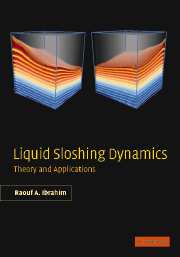Book contents
- Frontmatter
- Contents
- Foreword
- Acknowledgment
- Introduction
- Part I Linear sloshing dynamics
- Part II Nonlinear and parametric sloshing dynamics
- 4 Weakly nonlinear lateral sloshing
- 5 Equivalent mechanical models
- 6 Parametric sloshing: Faraday waves
- 7 Dynamics of liquid sloshing impact
- Part III Sloshing – structure interaction
- Part IV Rotating fluid and low gravity sloshing
- References
- Index
5 - Equivalent mechanical models
from Part II - Nonlinear and parametric sloshing dynamics
Published online by Cambridge University Press: 11 August 2009
- Frontmatter
- Contents
- Foreword
- Acknowledgment
- Introduction
- Part I Linear sloshing dynamics
- Part II Nonlinear and parametric sloshing dynamics
- 4 Weakly nonlinear lateral sloshing
- 5 Equivalent mechanical models
- 6 Parametric sloshing: Faraday waves
- 7 Dynamics of liquid sloshing impact
- Part III Sloshing – structure interaction
- Part IV Rotating fluid and low gravity sloshing
- References
- Index
Summary
Introduction
Generally, the liquid hydrodynamic pressure in rigid containers has two distinct components. One component is directly proportional to the acceleration of the tank and is caused by part of the fluid moving in unison with the tank. The second, known as “convective” pressure, experiences sloshing at the free surface. A realistic representation of the liquid dynamics inside closed containers can be approximated by an equivalent mechanical system. The equivalence is taken in the sense of equal resulting forces and moments acting on the tank wall. By properly accounting for the equivalent mechanical system representation of sloshing, the problem of overall dynamic system behavior can be formulated more simply. For linear planar liquid motion, one can develop equivalent mechanical models in the form of a series of mass-spring dashpot systems or a set of simple pendulums. For nonlinear sloshing phenomena, other equivalent models such as spherical or compound pendulum may be developed to emulate rotational and chaotic sloshing.
Graham (1951) developed an equivalent pendulum to represent the free-surface oscillations of a liquid in a stationary tank. Graham and Rodriguez (1952) introduced another model consisting of a sloshing point mass attached with springs to the tank wall at a specified depth and a fixed rigid mass. Pinson (1964) determined spring constants for liquid propellant in ellipsoidal tanks. Models in the form of mass-spring dashpot systems or a set of simple pendulums were considered by Ewart (1956), Bauer (1960a, 1961c, 1962b), Armstrong and Kachigan (1961), Abramson and Ransleben (1961c), Mooney, et al. (1964b).
Information
- Type
- Chapter
- Information
- Liquid Sloshing DynamicsTheory and Applications, pp. 296 - 337Publisher: Cambridge University PressPrint publication year: 2005
Accessibility standard: Unknown
Why this information is here
This section outlines the accessibility features of this content - including support for screen readers, full keyboard navigation and high-contrast display options. This may not be relevant for you.Accessibility Information
- 3
- Cited by
